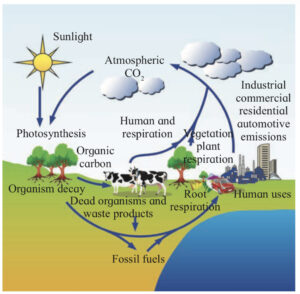Reservoir of Carbon:
1) Carbon, constituting 49% of organisms’ dry weight, serves as the primary component of all organic compounds in protoplasm, making all life forms on Earth carbon-based.
2) Approximately 71% of carbon exists dissolved in oceans, playing a crucial role in regulating atmospheric carbon dioxide levels.
3) Carbon stored in rocks and fossil fuels like oil, coal, and natural gas has remained separate from the general carbon cycle for an extended period, acting as long-term storage known as the sink.
4) Carbon is a fundamental element present in seawater, the atmosphere, rocks (e.g., limestone and coal), soils, and all living organisms.
Cyclic Pathway of Carbon:
1) Carbon, in the form of CO2, moves from the atmosphere to plants during photosynthesis, contributing to food production.
2) Carbon then progresses through food chains from plants to animals.
3) During exhalation, CO2 is released into the atmosphere, signifying the return of carbon from living organisms to the atmosphere.
4) Decomposers play a vital role in releasing CO2 into the atmosphere by processing waste materials and decomposing dead organic matter on land and in oceans.
5) Combustion of fossil fuels, as seen in factories, power plants, and motor vehicles, rapidly introduces carbon dioxide into the atmosphere.
6) The remaining carbon is dissolved in seawater and deposited as carbonate compounds, forming marine animal shells.
7) Additional sources of CO2 release include burning wood, forest fires, combustion of organic matter, fossil fuel usage, and volcanic activity.
8) The ocean absorbs atmospheric carbon in the form of CO2, with some fixed carbon lost to sediments, removing it from circulation.
Impact of Human Activities on the Carbon Cycle:
1) Human activities significantly impact the carbon cycle.
2) Deforestation and extensive burning of fossil fuels for energy and transportation notably accelerate the release of carbon dioxide into the atmosphere.
 Carbon Cycle
Carbon Cycle